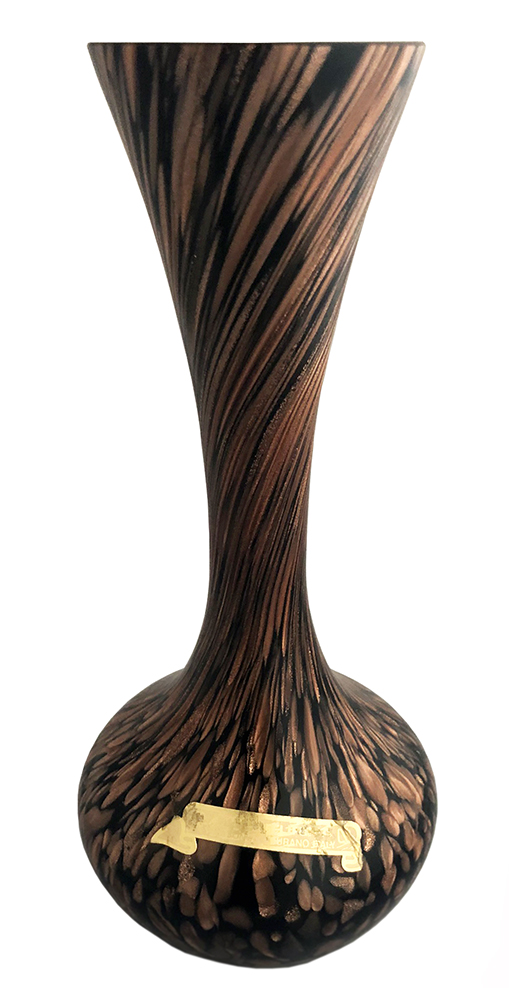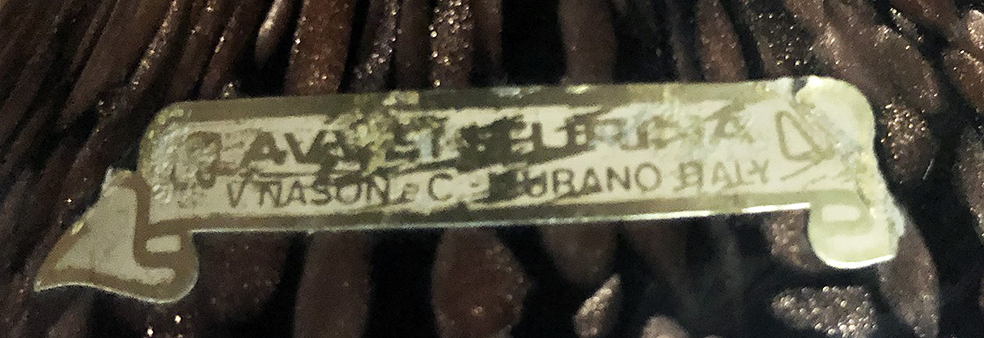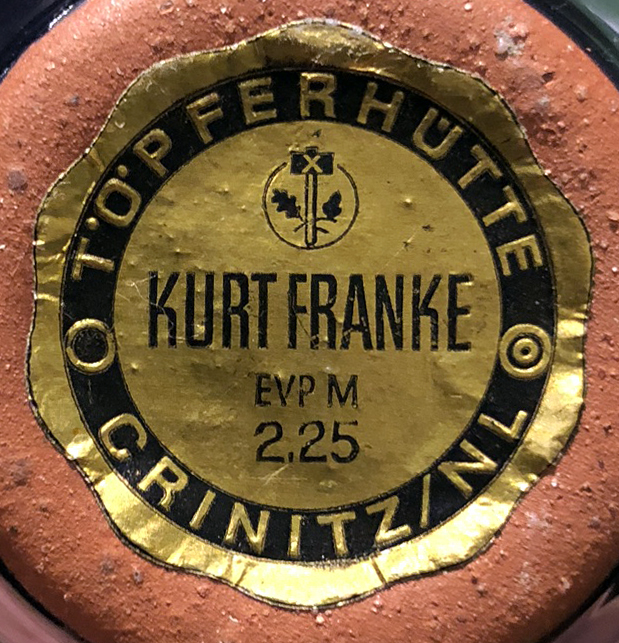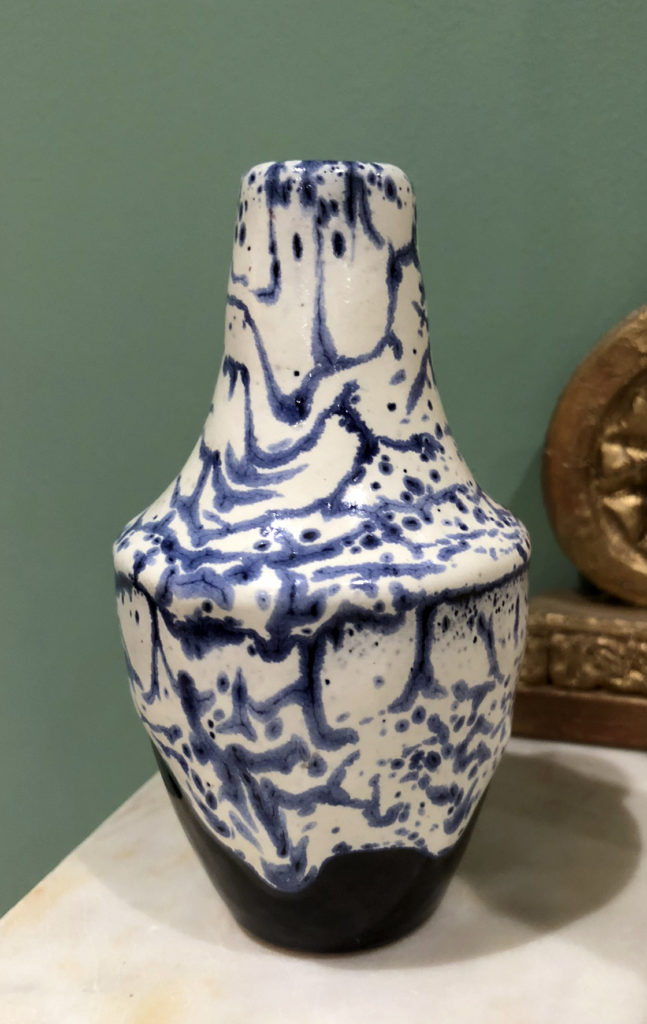I love finding a piece with its original label or sticker still attached, as it can yield a lot of useful information, especially if the piece is otherwise unmarked. Most labels were washed off, or otherwise removed, by the original owner when they got home, so survivors are scarce. Obviously, the first indication a label gives is who made, designed, distributed, or retailed a piece. It’s important to be able to distinguish between the four, and it’s not always easy. A quick google search will often help you or, better, look in a trusted reference book.
 In the past two weeks I’ve come across two things with labels which I had to buy. The first is a black Murano glass vase covered in sparkling ‘avventurine‘ coppery-gold mottles. It was made by rolling a partially-blown gob of black glass (actually very colour-heavy purple glass) in chips of colourless glass containing copper powder, and then applying a very thin layer of colourless glass over the top and blowing the whole into a mould. They’re not rare – if you go looking, you’ll find one pretty quickly, be it a vase, ashtray or a bowl. Prices range from a couple of pounds up to around £100-150 for extremely large examples.
In the past two weeks I’ve come across two things with labels which I had to buy. The first is a black Murano glass vase covered in sparkling ‘avventurine‘ coppery-gold mottles. It was made by rolling a partially-blown gob of black glass (actually very colour-heavy purple glass) in chips of colourless glass containing copper powder, and then applying a very thin layer of colourless glass over the top and blowing the whole into a mould. They’re not rare – if you go looking, you’ll find one pretty quickly, be it a vase, ashtray or a bowl. Prices range from a couple of pounds up to around £100-150 for extremely large examples.
 I’ve always wondered who made them and the scuffed embossed gilt label on my new acquisition tells me that it was made by V. Nason & C. on Murano and is from their ‘AVVENTURINA’ range. A number of companies used the name Nason, but V. Nason & C. appears to have been founded by Vincenzo Nason in 1967 and closed c2000. It’s best known for its opaline glass ands range of animal sculptures, but also produced this style of glass in large quantities in many different shapes. It may be related a company with the same name founded in 1934 by another Vincenzo Nason (died 1948), which was also known for its avventurine glass. Also bear in mind that copying was rife on Murano during the postwar period, so this style may have been made by other companies too.
I’ve always wondered who made them and the scuffed embossed gilt label on my new acquisition tells me that it was made by V. Nason & C. on Murano and is from their ‘AVVENTURINA’ range. A number of companies used the name Nason, but V. Nason & C. appears to have been founded by Vincenzo Nason in 1967 and closed c2000. It’s best known for its opaline glass ands range of animal sculptures, but also produced this style of glass in large quantities in many different shapes. It may be related a company with the same name founded in 1934 by another Vincenzo Nason (died 1948), which was also known for its avventurine glass. Also bear in mind that copying was rife on Murano during the postwar period, so this style may have been made by other companies too.
 The label on the second piece is arguably more interesting, and made me think on. Costing a 8 Euros from the brilliant Arkona Platz market in Berlin, I rather liked its compact shape twinned with the good quality blue veined, dripped glaze. At only 11cm (4.3in) high, it’s a lovely addition to my collection of miniature things. Turning it over revealed a fascinating label which my (German) partner decoded:
The label on the second piece is arguably more interesting, and made me think on. Costing a 8 Euros from the brilliant Arkona Platz market in Berlin, I rather liked its compact shape twinned with the good quality blue veined, dripped glaze. At only 11cm (4.3in) high, it’s a lovely addition to my collection of miniature things. Turning it over revealed a fascinating label which my (German) partner decoded:
- Kurt Franke is the name of the pottery (Töpferhütte), which is still in existence today, run by its third generation family owners. The company was still privately held when my pot was made as there’s no VEB suffix (Volks Eigener Betrieb – People’s Owned Company), showing that it was small and not worth nationalising. Instead, most small artisan companies like Kurt Franke were forced to become part of a PGH (Produktions Genossenschaft Des Handwerks), a process which began in the 1950s and finished by the 1970s. So if you had five independent potteries close together in a geographical area, they’d be amalgamated into a cooperative of five companies in one PGH. These PGHs were not goverment owned, but were owned by the PGH and its members.
- EVP is the Einzelhandelsverkaufspreis, or Communist government-applied ‘Unified Sales Price’ (RRP), which was 2.25 Marks.
- The use of M (Marks) indicates it was made from 1969 onwards. Until 1963, DM (Deutschmarks) was used, then from 1963-69 MDN (Mark Denotenbank DDR) was used. I had thought that my vase would have dated from the 1950s, due to the style and label, but this shows the fact that much design and progression stagnated in Eastern Europe from the late 1960s onwards.
- NL is Nieder Lausitz, which indicates Lower Lusatia, a region of East Germany.
 So that got me thinking…looking on the internet at comparative prices for products in 1970s East Germany allowed me to position the price of the vase in a real life context:
So that got me thinking…looking on the internet at comparative prices for products in 1970s East Germany allowed me to position the price of the vase in a real life context:- 2.25 Marks would buy two large beers in a bar.
- 2.35 Marks would buy a simple lunch in a restaurant of ‘price level 2’ (Maybe like Starbucks today).
- 2.50 Marks would buy half a pound of butter.
- 2.50 Marks would buy five large loaves of bread or 50 cheap and small bread rolls (currently 11p each in Sainsbury’s)
- 2.50 Marks would let me send 12 letters via a 1970s East German post office.
- 2.50 Marks would buy me 12 tram tickets.
Looking wider, the average monthly income of a 4 person household family in East Germany in 1981 was 1,700 Marks (The average monthly net income for the same in the UK today, after tax, is around £2,000 per month). Money was pretty tight for 1970s East German families, as was supply of many goods. Anything considered ‘basic’ or ‘essential’ was inexpensive, but anything deemed vaguely luxurious or unecessary for day-to-day living was expensive, and prices remained pretty similar throughout Communist rule in East Germany from 1945-89.
- A quarter of a pound of coffee cost 8.25 Marks.
- A packet of 20 cigarettes cost between 1 Mark and 3.20 Marks.
- A ‘pop record’ was 16.10 Marks, whilst a classical music record was 12.10 Marks.
- A Trabant cost 14,000 Marks, and you had to wait for it – often for years.
- A 69 square metre new ‘Plattenbau‘ apartment with all the mod cons cost 93.10 Marks per month to rent and a 40 square metre old, unrenovated ‘Altbau‘ apartment in East Berlin with coal heating cost 25 Marks per month to rent.
- A washing machine cost 2,990 Marks, and 4.65 Marks would buy a box of washing detergent to use in it.
- A colour TV was 4,100 Marks in 1983, and the same with a remote control cost 6,900 Marks in 1989.
- A serving of caviar in East Berlin’s equivalent of Stringfellow’s cost 18.95 Marks in 1983.

